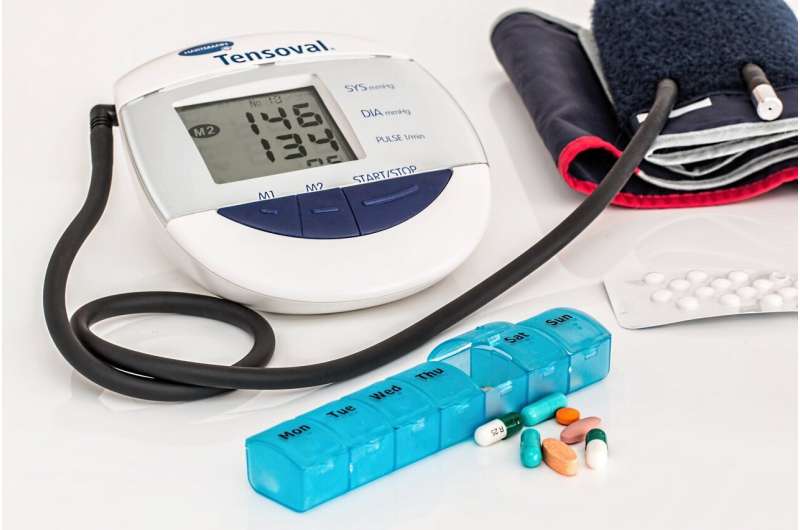
U.S. adults with both hypertension and type 2 diabetes (T2D) face a significantly higher risk of all-cause and cardiovascular mortality compared to those with only one of these conditions—or neither, reports a new study from Columbia University Mailman School of Public Health.
The results also reveal that even the combination of prediabetes and elevated blood pressure, representing risk states that precede progression to T2D and hypertension, respectively, is linked to higher mortality risk.
The findings are published in the journal Diabetes Care.
“Hypertension affects nearly half of U.S. adults, and prevalence is projected to increase to 61% by 2050. Type 2 diabetes currently affects about 15% of U.S. adults, and over one-third have prediabetes. Without intervention, more than half of those with prediabetes will develop diabetes,” said Nour Makarem, Ph.D., assistant professor of Epidemiology and co-leader of the Chronic Disease Unit at Columbia University’s Mailman School of Public Health and the study’s senior author.
“Importantly, there is a growing population of U.S. adults living with co-existing T2D and hypertension, putting them at increased risk for cardiovascular disease and mortality. This underscores the urgent need for public health strategies to effectively prevent and manage these conditions and reverse these adverse trends.”
Researchers analyzed data from 48,727 adults participating in the National Health and Nutrition Examination Survey (1999–2018), representing approximately 200 million U.S. adults. Participants were categorized into four groups: no hypertension or T2D; hypertension only; T2D only; and both conditions.
Between 1999 and 2018, the prevalence of coexisting hypertension and T2D increased from 6% to 12% in the U.S. population. The study found that coexisting hypertension and T2D were more common among older adults, those with lower income and education levels, and were disproportionately prevalent among non-Hispanic Black and Hispanic adults compared with non-Hispanic white adults.
“One of the strengths of our study is the use of nationally representative data spanning two decades. A striking finding is that the burden of co-existing hypertension and type 2 diabetes nearly doubled over the study period. Overall, about two-thirds of participants with diabetes also had hypertension, and about a quarter of adults with hypertension had concurrent diabetes,” said Makarem.
Mortality rates were highest among those with both conditions. Over a median follow-up period of 9.2 years, about a third of participants with co-existing hypertension and T2D died, compared with 20% of those with T2D only, 22% of those with hypertension only, and just 6% of those with neither condition.
The study found that having co-existing hypertension and T2D doubles the risk of dying from any cause and triples the risk of dying from cardiovascular disease, compared to having neither of these conditions. These associations were observed across all racial and ethnic groups and in both sexes, but were generally stronger in females compared with males.
“Even having co-existing prediabetes and elevated blood pressure was associated with up to 19% higher mortality risk, compared to having neither or either of these risk states,” said Makarem.
“This suggests that the increase in risk of dying commences before levels of blood glucose and blood pressure progress to Type 2 diabetes and hypertension.”
Study findings also showed that co-existing T2D and hypertension are associated with substantially higher mortality risk compared with having either condition (T2D only or hypertension only).
Specifically, compared to having hypertension only, having co-existing T2D and hypertension was linked to a 66% and 54% higher risk of dying from any cause and from cardiovascular disease, respectively.
On the other hand, compared to having diabetes only, having co-existing T2D and hypertension was related to a 25% higher risk of dying from any cause and more than double the risk of dying from heart disease.
These results highlight the importance of routine screening for both blood pressure and glucose—particularly in communities with high rates of cardiometabolic disease. Makarem and co-authors advocate for investing in prevention efforts as well as integrated management strategies, including improved medication adherence and adoption of evidence-based lifestyle interventions.
“Given the aging U.S. population and the projected rise in chronic disease, our findings underscore the urgent need for innovative public health interventions and policies that address multiple cardiometabolic conditions simultaneously and prioritize chronic disease prevention and the extension of health span, meaning the number of years of life lived healthy,” said Makarem.
More information:
Ye Yuan et al, Associations of Concurrent Hypertension and Type 2 Diabetes With Mortality Outcomes: A Prospective Study of U.S. Adults, Diabetes Care (2025). DOI: 10.2337/dca24-0118
Columbia University Irving Medical Center
Citation:
Burden of coexisting hypertension and type 2 diabetes in U.S. adults is increasing, study reveals (2025, May 29)
retrieved 29 May 2025
from https://medicalxpress.com/news/2025-05-burden-coexisting-hypertension-diabetes-adults.html
This document is subject to copyright. Apart from any fair dealing for the purpose of private study or research, no
part may be reproduced without the written permission. The content is provided for information purposes only.

